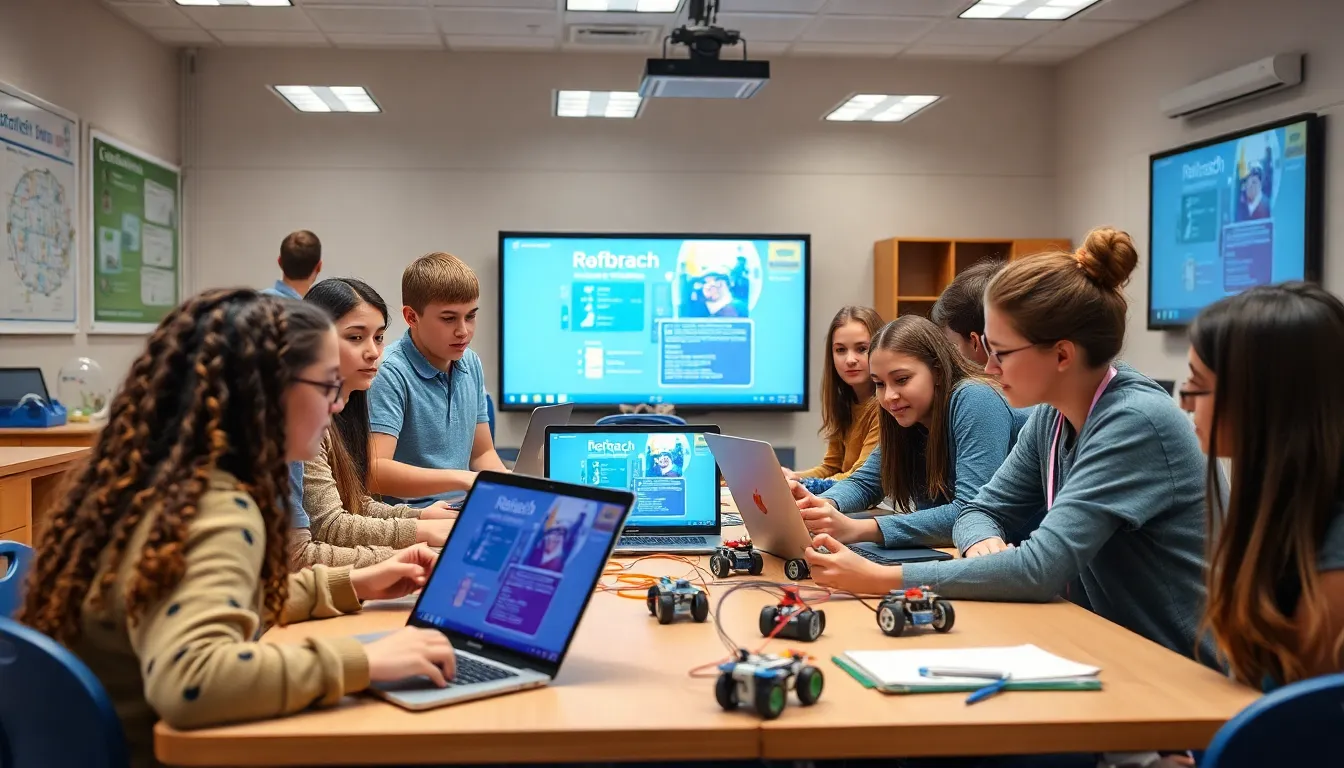In a world where learning can sometimes feel as exciting as watching paint dry, educational programming swoops in like a superhero with a cape made of colorful pixels. It’s not just about crunching numbers or memorizing facts; it’s about engaging minds and sparking creativity. Whether it’s coding a video game or designing a robot, educational programming turns the mundane into the magnificent.
Educational Programming
Educational programming enhances the learning experience by integrating creativity and technology. It reshapes traditional learning methods into interactive activities.
Definition of Educational Programming
Educational programming involves using computer coding and technology to facilitate learning across various subjects. It includes engaging methods such as game development and robotics. These activities allow students to apply their knowledge in practical ways. The focus often shifts from passive learning to active participation, fostering problem-solving skills. Programs designed around educational programming aim to inspire curiosity and critical thinking.
Importance in Today’s Learning Environment
In today’s learning environment, educational programming serves a crucial role in developing digital literacy. Students gain necessary skills for future job markets where tech proficiency is essential. Engagement levels rise when students participate in hands-on projects. Research indicates that learners retain information better when involved in creative processes. Collaboration becomes a key component, as many projects require teamwork. Overall, educational programming aligns well with contemporary educational goals, preparing students for the digital age.
Types of Educational Programming

Educational programming comes in various formats, catering to different learning environments and needs. Each type enhances the educational experience.
Classroom-Based Educational Programming
Classroom-based educational programming integrates technology directly into the classroom setting. Teachers use tools like coding platforms and interactive software to engage students. Workshops present collaborative opportunities, allowing learners to tackle projects together. Projects in these settings often lead to hands-on experience with problem solving. Students gain practical skills through coding exercises and robotics initiatives. Evaluation methods often include assessing student participation and project outcomes.
Online Educational Programming
Online educational programming expands learning beyond the physical classroom. Virtual platforms provide access to a wide array of courses. Learners can engage in coding tutorials and digital workshops at their own pace. These online resources often offer interactive elements, ensuring active participation. Many platforms also allow students to connect with peers globally for collaborative projects. Flexibility in scheduling makes this format accessible to a broader audience.
Interactive and Gamified Educational Programming
Interactive and gamified educational programming utilizes game mechanics to enhance learning. Through games, students encounter challenges that promote critical thinking and creativity. Elements such as rewards and achievements motivate learners to engage fully. Projects often include developing educational games or simulations, allowing students to apply their knowledge practically. Feedback is immediate, fostering a growth mindset in students. This approach not only keeps learners interested but also encourages teamwork in many projects.
Benefits of Educational Programming
Educational programming offers numerous advantages for learners, enhancing engagement and skill development.
Enhancing Learning Outcomes
Educational programming significantly improves learning outcomes by making subjects more interactive and enjoyable. Students demonstrate better knowledge retention when engaged in hands-on activities like coding and robotics. These experiences allow them to apply theoretical concepts in real-world scenarios, solidifying their understanding. Research indicates that learners exposed to creative endeavors outperform their peers in traditional settings. Involving technology in education motivates students, allowing them to explore complex subjects in accessible ways.
Promoting Critical Thinking and Problem-Solving Skills
Critical thinking and problem-solving skills flourish through educational programming. Programming challenges require students to analyze situations and develop solutions, often resulting in a deeper understanding of the material. Each coding task or robotics project encourages creative approaches and experimentation, fostering resilience in tackling obstacles. In turn, these skills become essential for future academic and professional success. Developing a mindset geared towards exploration empowers students to face challenges confidently, preparing them for diverse pathways.
Encouraging Collaboration and Communication
Collaboration and communication thrive in educational programming environments. Many projects necessitate teamwork, where learners share ideas and work towards common goals. Such collaboration teaches students the value of diverse perspectives, enhancing their interpersonal skills. Students often engage in discussions to articulate their thoughts, leading to improved communication abilities. By participating in group projects, learners develop trust and respect for one another, creating a supportive atmosphere that promotes shared learning experiences.
Challenges in Educational Programming
Educational programming faces various challenges that can hinder its effective implementation. Resource limitations and resistance to change in teaching methods often stand out.
Resource Limitations
Limited resources frequently restrict access to necessary technologies and materials. Schools may not have adequate funding to invest in high-quality software or training for educators. Insufficient access to devices like laptops or tablets can also impede students’ ability to participate fully. Educators who lack training in educational programming may struggle to integrate these tools into their curricula. Such limitations can ultimately diminish the potential benefits of educational programming, making it essential to prioritize funding and resource allocation.
Resistance to Change in Teaching Methods
Resistance to change often hampers the adoption of educational programming in classrooms. Many teachers are accustomed to traditional teaching practices and may hesitate to embrace new methodologies. Concerns about technological proficiency can create barriers, as educators might doubt their ability to teach programming effectively. Also, some may perceive educational programming as a trend rather than a necessary evolution in teaching strategies. Addressing these concerns through professional development and support can facilitate a smoother transition towards integrating programming into education.
Conclusion
Educational programming stands at the forefront of modern learning. By transforming traditional subjects into engaging, hands-on experiences, it cultivates essential skills like critical thinking and problem-solving. Students not only gain knowledge but also learn to collaborate effectively, preparing them for a tech-driven future.
While challenges exist in implementing educational programming, addressing these hurdles can unlock its full potential. With the right resources and training, educators can create dynamic learning environments that inspire curiosity and creativity. Embracing this approach not only enhances educational outcomes but also equips students with the tools they need to thrive in an increasingly digital world.

